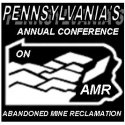Abandoned Mine Drainage, or AMD, is polluted water that flows out of abandoned mines. This water is often laden with heavy metals and net acidic, with no two discharges having the same chemistry. When it’s acidic (lower than 7 pH), it’s called Acid Mine Drainage. When it’s alkaline (higher than 7 pH), it’s called Alkaline Mine Drainage. Metals can range from a few to thousands of parts per million (or milligrams per liter – mg/L) in solution or as a precipitated sludge. In the Anthracite Region, most of the drainage is near neutral, laden with less than 100 mg/L iron originating from underground coal mines.

Above is a panoramic view of the Gravity Slope Discharge near Peckville, PA in the Lackawanna River Watershed. The chemistry is as follows: pH = 6.2, Acidity = 68.4 mg/l, Alkalinity = 34.2 mg/l.


Above are a few shots of abandoned mine discharges that flow into streams in the Wyoming Valley, PA. In general for these sites, the stream bed is coated with a thick orange precipitate (liquid rust), smells like rotten eggs, and supports very little to no aquatic life. The image to the left is the last remaining Solomon Creek Borehole from the 1970’s. In 2014, 4 new boreholes were drilled after the 3 original ones either collapsed or were in danger of collapsing. The photo to the right is of the Susquehanna #7 Airshaft Discharge to Newport Creek, also known as Honey Pot.
The panoramic above is of the Phase 1 Seep Discharge that flows to Espy Run, a tributary to Nanticoke Creek near Nanticoke, PA . The chemistry is as follows: pH = 6.5, Acidity = 22.3 mg/l, Alkalinity = 307.8 mg/l. See the AMD Passive Treatment Systems Page for a picture of the wetlands treatment system that was constructed to treat this discharge.


To the Left is an AMD discharge from the Green Mountain Tunnel near Sheppton with a pH of around 4 and about 8 mg/l of aluminum. The “wetland” is devoid of aquatic life since their tolerance for dissolved aluminum is below 2 mg/l. The aluminum is transported miles downstream in the Catawissa Creek until it finally meets water above pH 6 and drops out as a white precipitate. To the Right is a photo of the Ashland Fountain, a discharge in the village of Big Mine Run just east of Ashland. It erupts when the mine pool is high. A Shamokin Creek Restoration Alliance (SCRA) Member stands by for scale.

The photo above shows the Excelsior Strip Pit discharge to the Shamokin Creek not far from Shamokin, PA. It changes color – deep bluish green to a reddish orange – depending on the condition of the mine pool and how much oxygen is available to help remove iron and aluminum.
Want to see more pictures of AMD? Go to the AMD Section of Our Photo Gallery.
Want to know about their Water Chemistry? See the USGS Report : Water Quality of Large Discharges from Mines in the Anthracite Region of Eastern Pennsylvania by Charles R. Wood (1996).
Several Pots of money are available to “Remediate” mine drainage in PA (here are a few):
- Growing Greener managed by the Pennsylvania Department of Environmental Protection
- Nonpoint Source Program (PA DEP 319) managed by the Pennsylvania Department of Environmental Protection
- Bureau of Abandoned Mine Reclamation (PA DEP BAMR) Surface Mining Control and Reclamation Act (SMCRA) Title 4 Set-Aside managed by the Pennsylvania Department of Environmental Protection
- USDA Small Watershed Program (PL 83-566













Pingback: The Paradox of Pollution and Art - Ashley's Breaker